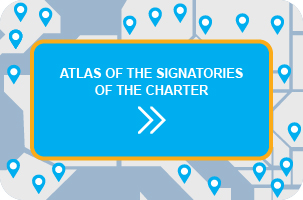Evaluation
In 2009, the Council of European Municipalities and Regions (CEMR) developed indicators to certain articles of the Charter in order to support local and regional authorities in monitoring the implementation of their action plan.
These ideas identifying indicators have drawn on the experiences and comments of the CEMR national associations of local and regional authorities.
You are invited to use indicators that you consider relevant according to the particular realities of your territory.
Article 1 – Democratic accountability
- Percentage of men and percentage of women elected to local government
Article 2 – Political representation
- Percentage of men and percentage of women elected to local government
- Percentages representing the numbers of male and female candidates who were successfully elected
- Percentages for each gender holding mandates with political responsibility within your local government (Deputy to the Mayor, Chair of a Committee, etc.)
Article 3 – Participation in political and civic life
- Percentage of women and percentage of men in the local public consultative bodies (neighbourhood councils, consultative committees, etc.)
- Percentage of women and percentage of men in the administration councils of associations which receive subsidies from the local authority
Article 4 – The public commitment for Equality
- Was the signing of the charter publicised or made an event? Is so, how?
- Has your local authority adopted an equality action plan since it signed the Charter?
- Does your local authority issue progress reports on the implementation of the Equality Action Plan? If so, how is this done? If so, how often?
Article 5 – Working with partners to promote equality
- Has your local authority undertaken consultations with its partner bodies and organisations, including its social partners, on your Equality Action Plan?
Article 6 – Countering stereotypes
- Does your local authority provide training sessions or workshops for staff members and elected officials aimed at countering stereotypes based on gender?
- If so, what percentage of your staff receives this type of training? How many are men and how many are women?
- If so, what percentage of elected officials receives this type of training? How many of them are men and how many are women?
Article 9 – Gender assessment
- Does your local authority undertake gender assessments relating to its principal areas of competence?
- Does an official and endorsed equality action plan exist?
Article 10 – Multiple discrimination or disadvantage
- What is the percentage of your territory’s population who are of different ethnic origin or immigrants? (Insofar as such surveys are legally authorised) Of this total percentage, what is the breakdown by gender, in percentage?
- What percentage of women of different ethnic origin or female immigrants in your area is employed and what percentage is out of work?
- What percentage of men of different ethnic origin or male immigrants in your area is employed and what percentage is out of work?
- Has your local authority taken any specific measures to combat multiple discrimination in its local equality action plan?
Article 11 – The employer role
- Average salary of your employees in your local administration, analysed by gender and level of position
- Calculation in percent of the gap in salaries between the average income of male and female employees holding an equivalent position level
- Percentage of female employees within your local authority who occupy posts traditionally viewed as masculine and vice-versa (and taking into account, if possible, the different position levels)
- Percentage of women and percentage of men employed part-time within your local authority, for each position level if possible
- Has your local authority adopted and implemented policies against sexual harassment in the workplace?
- Has your local authority adopted positive actions relating to hiring/promotion policies in favour of equality between women and men?
Article 12 – Public procurement and contracts
- In your local authority, how many major contracts were signed within the past year, the specifications of which contain provisions taking gender perspectives into account?
- Does your local authority provide gender perspective training for local authority personnel in charge of preparing call for tenders relating to public procurement?
- If so, how many receive such training?
Article 13 – Education and lifelong learning
- What is the percentage of each gender employed in local educational structures, broken down by age groups (childcare/kindergarten, primary school, secondary school, etc.)?
- What is the percentage for those holding senior/management positions in educational establishments?
- What is the percentage of personnel employed by your local authority who have received training with respect to gender issues within the local educational structures, broken down by age groups (childcare/kindergarten, primary school, secondary school, etc.)?
- Has your municipality carried out an evaluation of the content of the teaching materials using a gender-based approach?
- Has your local authority taken any measures, in or with local schools and educational establishments, to promote non-traditional career choices for women and men?
Article 14 – Health
- What percentage of the budget allocated to healthcare is set aside for actions highlighting the specific and different needs of women and men? (If local government has jurisdiction over healthcare in your area)
- Has your local authority undertaken gender-based health education initiatives?
- Has your local authority undertaken steps to carry out a gender-based assessment of local health services?
Article 15 – Social care and services
- What is the percentage of each gender that benefits from the authority’s local social assistance services, broken down by category of services or care (e.g. mental illness, care for the elderly, etc.)?
- Has your local authority evaluated feedback in terms of the needs and satisfaction of women and men who use social care and assistance services?
Article 16 – Childcare
- Number of children under school age in your local area
- Number of approved childcare places offered in your local area for children under school age broken down by age groups
- Do childcare services exist for your administration’s employees?
- If so, what is the percentage of families who use such services?
Article 17 – Care of other dependants
- Total percentage of women and men who work part-time in the public administration and who have to care for dependants other than children (elderly persons who are vulnerable, those with a serious disability, etc.) Of this total, what are the percentages for each gender?
- If your local authority can estimate the number of full-time carers existing in your local area devoted to the care of other dependants, what are the percentages gender-wise who are concerned?
- How many people occupy serious full-time jobs in social care and services in your local area? What percentage of these people are women? What percentage of these people are men?
- Does your local authority provide support to them?
Article 18 – Social inclusion
- Do your social inclusion programmes incorporate a gender-based assessment?
- What is the total number of unemployed persons surveyed in your local area?
- What are the percentages of this total according to gender?
- Percentage of the local population receiving social aid, broken down by category and by gender
- Estimated percentage of women and men among the total population who do not speak the main language in use in your local area
Article 19 – Housing
- Estimated number of people living in substandard accommodation, broken down by gender of the head(s) of household
- Percentage of female and male single-parent families in such accommodation
- Estimated number of people who are homeless or in a precarious housing situation, broken down by gender
- Estimated number of people, homeless or in a precarious housing situation, who were re-housed within one year, broken down by gender
Article 20 – Culture, sport and recreation
- Percentages for both women and men who are members of the local sporting associations administrative boards
- Percentages for both women and men who are members of the local cultural associations administrative boards
- Percentages of the total budget allocated to sporting equipment and activities set aside for sports viewed as traditionally female or traditionally male
- Do you organise and finance initiatives to encourage women to practice traditionally male sport activities and vice-versa?
Article 21 – Safety and security
- Total number of victims of incidents (including serious crime against the individual) affecting security and safety, analysed by category of crime (to be defined locally), per year
- What are the percentages, by gender and by category, of victims?
- Does your local authority measure people’s fear of crime using a gender-based approach?
Article 22 – Gender-based violence
- Total number of reported incidents of gender-based violence per year
- What percentage of these reported incidents concerned violence against women?
- What is the percentage of incidents reporting violence against men?
- Has your local authority undertaken any measures to prevent gender-based violence (e.g. public awareness campaigns, training of specialised personnel, etc.)?
- Does your authority provide or finance specific support measures for victims of gender-based violence (e.g. refuges, shelters, etc.)?
Article 23 – Human trafficking
- Does your authority provide or finance specific support measures for victims of human trafficking?
Article 26 – Mobility and transport
- Has your local authority drawn up a transport or mobility plan which takes into account the specific habits and needs of women and men?
- Overall number of people using public transport, by gender
- Number of people using public transport, analysed by gender, and by zone or by route or by means of transport (to be defined according to your local context)
- Does your local authority measure satisfaction among the population with the local mobility and transport infrastructures, taking into account the views of women and men separately?
Article 27 – Economic development
- Does your local authority undertake and/or finance measures to encourage women trainees to learn skills traditionally seen as male, and vice versa?
- Does your local authority undertake and/or finance measures to encourage employers to recruit women trainees in relation to skills and positions traditionally seen as male, and vice versa?
Article 30 – Twinning and international cooperation
- Among your local authority’s European twinning or international co-operation actions, are there any projects concerning equality between women and men?
- Number of women and men taking part in twinning activities per year















